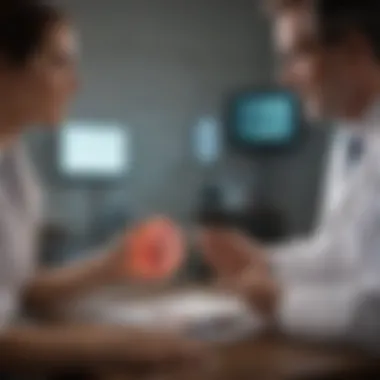Recognizing Early Symptoms of Liver Cancer


Intro
Liver cancer remains a critical health issue across the globe. Its complex nature often leads to a delay in diagnosis and treatment. The vague symptoms associated with the disease can be easily misconstrued as benign conditions. Therefore, understanding the signs of liver cancer is essential for timely intervention. This article presents a comprehensive analysis of these signs, offering valuable insights to help both healthcare professionals and the general public recognize potential indicators of liver cancer.
The focus will be on the clinical manifestations of liver cancer, from early to advanced symptoms. Awareness of these signs can significantly improve diagnosis rates and subsequent patient outcomes. Furthermore, this article explores the risk factors linked to liver cancer and the importance of early detection.
Recent Advances
In recent years, there have been notable advancements in the understanding of liver cancer. Research continues to shed light on various aspects of the disease, enhancing diagnosis and treatment options.
Latest Discoveries
Recent studies have identified several molecular markers associated with liver cancer. These markers can help clinicians in diagnosing the disease earlier than traditional methods. Additionally, ongoing research into genetic predispositions has revealed potential hereditary links, indicating that certain populations may need more vigilant monitoring.
Technological Innovations
Technology plays a vital role in the detection of liver cancer. Innovations such as advanced imaging techniques, including MRI and PET scans, allow for better visualization of liver tumors. Furthermore, artificial intelligence algorithms are being developed to analyze imaging results, potentially identifying cancerous formations quicker and more accurately.
"Early detection significantly boosts survival rates in liver cancer patients, making awareness key."
Key Signs of Liver Cancer
Understanding the signs of liver cancer can empower individuals to seek medical advice sooner. Below are the common signs:
- Unexplained Weight Loss: Significant, unintended weight loss can be a red flag.
- Abdominal Pain and Swelling: Persistent pain or swelling in the upper right abdomen may indicate liver stress or damage.
- Jaundice: A yellowing of the skin and eyes suggests liver dysfunction.
- Fatigue and Weakness: Constant fatigue can be misattributed but is a common symptom of liver issues.
- Changes in Appetite: A sudden decrease or change in appetite could signal underlying health issues.
- Nausea or Vomiting: Persistent nausea, especially if accompanied by other symptoms, warrants attention.
Risk Factors
Understanding risk factors in liver cancer is crucial. Some known risk factors include:
- Hepatitis Infections: Chronic infections with hepatitis B or C can significantly increase risk.
- Alcohol Consumption: Excessive alcohol intake damages the liver over time, contributing to liver disease and cancer.
- Obesity: Obesity and associated conditions like diabetes are linked to higher liver cancer rates.
- Exposure to Aflatoxins: Consuming aflatoxin-contaminated foods may also increase risk.
Recognizing these factors can encourage proactive monitoring and lifestyle adjustments.
Closure
Being informed about the signs of liver cancer is necessary for effective health management. Early diagnosis through understanding symptoms and considering risk factors can lead to better outcomes for patients. Continuous research and technological advancements promise improvements in both detection and treatment of liver cancer, offering hope against this serious disease. Educational efforts are essential in spreading awareness and recognizing the critical signs that could save lives.
Prelims to Liver Cancer
Liver cancer is a pervasive health issue that demands significant attention due to its complex nature and rising incidence rates. Understanding liver cancer is essential not only for healthcare professionals but also for the general public who may experience early signs. This section will delve into the various aspects of liver cancer and underline its relevance in today's medical landscape. An early and accurate identification of liver cancer symptoms can greatly improve treatment outcomes and overall survival rates.
Understanding Liver Cancer
Liver cancer primarily originates from the liver itself and can be classified into two main types: primary liver cancer and secondary liver cancer. Primary liver cancer begins in the liver cells, with hepatocellular carcinoma being the most prevalent form. Secondary liver cancer, on the other hand, occurs when cancer cells from other parts of the body spread to the liver. This cancer type often complicates the diagnosis and treatment strategy, making early symptom recognition crucial.
Several risk factors contribute to the development of liver cancer, including chronic liver diseases, hepatitis infections, and lifestyle choices such as alcohol consumption. An in-depth understanding of liver cancer aids in recognizing patterns of symptoms and planning appropriate interventions.
Prevalence and Statistics
Liver cancer is not only a significant health concern but also a disease marked by alarming prevalence statistics globally. According to the World Health Organization, liver cancer ranks as one of the leading causes of cancer-related deaths worldwide.
- In 2020, over 900,000 cases of liver cancer were reported, with the incidence steadily increasing.
- The geographical distribution shows a higher incidence in regions such as sub-Saharan Africa and Southeast Asia, largely due to endemic hepatitis B and C infections.
"The increasing rates of liver cancer underscore the need for vigilant screening and public awareness.
For individuals with a higher risk of liver cancer, such as those with chronic liver diseases, regular screening is vital. The complexity of liver cancer, due to its often asymptomatic early stages, makes these statistics even more concerning.
In summary, awareness around liver cancer is critical. A comprehensive understanding of the disease, coupled with knowing the prevalence and risk factors, is crucial for improved patient outcomes. This foundation sets the stage for further exploration into symptoms and diagnosis in the following sections.
Anatomy of the Liver
Understanding the anatomy of the liver is crucial for comprehending its role in the human body and the implications of liver cancer. The liver is a vital organ that functions in digestion, metabolism, and detoxification. Its anatomy provides insight into how cancer can disrupt these essential processes.
The liver is often described as the body's chemical factory. It performs numerous functions that are critical to maintaining homeostasis. This includes the regulation of blood sugar levels, synthesis of proteins, and production of biochemicals necessary for digestion. An awareness of liver structure and function is important for recognizing how cancer might affect these processes.
Liver Structure and Function
The liver is the largest internal organ, located in the upper right portion of the abdomen. It is divided into two main lobes, each composed of thousands of lobules. These lobules are functional units where bile is produced, and blood is filtered. The liver receives blood from two sources: the hepatic artery, which provides oxygen-rich blood from the heart, and the portal vein, which supplies nutrient-rich blood from the gastrointestinal tract.
Key Functions of the Liver:
- Metabolism: The liver converts carbohydrates, fats, and proteins from the food we eat into essential nutrients for energy and cellular function.
- Detoxification: It metabolizes drugs and toxins, rendering them less harmful and facilitating their removal from the body.
- Bile Production: Bile helps in the digestion and absorption of fats and fat-soluble vitamins in the intestine.
- Synthesis of Proteins: The liver produces various proteins, including albumin, which is critical for maintaining blood volume and pressure.


These functions illustrate how a disease like liver cancer can severely compromise the body's health. Symptoms may arise not just from the presence of tumors but also from the liver's diminished ability to carry out its normal functions.
"Understanding the liver’s anatomy and function is essential for identifying how liver cancer may manifest and progress."
The liver’s unique attributes influence how cancer develops and spreads. For instance, cancer can obstruct bile ducts, leading to jaundice and other complications. The intricate vascular supply makes it prone to metastatic disease. Thus, thorough knowledge of the liver’s anatomy is necessary for early detection and treatment of liver cancer.
Risk Factors for Liver Cancer
Understanding the risk factors for liver cancer is essential for both prevention and early detection. Risk factors can serve as warning signs guiding individuals toward possible preventative measures or early diagnostic interventions. By identifying these risk elements, healthcare professionals can develop targeted screening strategies and health guidelines that may lead to improved outcomes for at-risk populations. As liver cancer is often diagnosed at a later stage due to nonspecific symptoms, recognizing these risk factors enhances awareness and may encourage individuals to seek timely medical advice.
Chronic Liver Disease
Chronic liver disease plays a pivotal role in the development of liver cancer. Conditions such as cirrhosis and non-alcoholic fatty liver disease significantly increase the risk. Cirrhosis, which can result from alcohol abuse, hepatitis infections, or autoimmune disorders, creates an environment conducive to cellular mutations and tumor formation.
People with chronic liver conditions should monitor their health closely, as the liver's ongoing damage promotes cancer progression. Regular screenings and consultations with healthcare providers can help in managing potential complications and lead to timely interventions. It is critical to note that chronic liver disease may show few symptoms until advanced stages, making vigilance crucial.
Hepatitis B and Virus Infection
Hepatitis B and C virus infections are well recognized as major risk factors for liver cancer. These viruses can cause chronic liver inflammation, leading to cellular damage over time. For individuals infected with hepatitis B or C, the odds of developing liver cancer considerably rise.
Once chronic infection establishes, it may take several years or even decades for liver cancer to develop. Hence, patients infected should receive consistent medical surveillance. Antiviral treatments can be available for both viruses and may mitigate the ensuing risk of liver cancer significantly. Educating those at risk is vital for understanding how these infections contribute to potential malignancies.
Alcohol Consumption
Excessive alcohol consumption is another significant risk factor for liver cancer. Chronic alcohol intake can lead to liver cirrhosis, which is often a precursor to cancer. The liver processes alcohol through metabolic reactions that generate toxic by-products, leading to oxidative stress, inflammation, and tissue damage.
Moderation is key, and individuals with a history of heavy drinking should evaluate their consumption patterns. Health strategies focused on alcohol education and reduction can prevent the onset of disease related to liver impairment. Furthermore, individuals should seek healthcare guidance if they have a history of heavy drinking to better understand their risk.
Obesity and Diabetes
Obesity and diabetes are increasingly recognized contributors to the risk of liver cancer. The accumulation of fat in liver cells, known as steatosis, triggers inflammation and fibrosis. These conditions create a pathway to hepatocellular carcinoma. Diabetes, especially type 2, is closely linked to fatty liver disease and poses an additional risk factor.
Maintaining a healthy weight and managing blood sugar levels are crucial for prevention. Regular check-ups and lifestyle modifications, such as diet and exercise, can significantly reduce overall health risks while also targeting liver health specifically. Awareness regarding these links can empower individuals to take actionable steps towards their health.
Regular health screenings and lifestyle counseling are critical for those with risk factors. They can guide interventions that reduce the likelihood of developing liver cancer.
Signs and Symptoms of Liver Cancer
Understanding the signs and symptoms of liver cancer is crucial for timely intervention and management. Symptoms often appear vague and can be attributed to various other conditions. Because of this, awareness becomes vital for both patients and healthcare providers. Recognizing early signs can lead to earlier diagnosis and better outcomes. This section explores the early symptoms, advanced symptoms, and specific clinical signs associated with liver cancer, providing a comprehensive overview. Knowledge in this area can directly influence survival rates and treatment effectiveness.
Early Symptoms
Early symptoms of liver cancer can be subtle and often overlooked. Patients may experience fatigue, which can gradually worsen over time. This tiredness is not just ordinary tiredness; it can feel like a persistent lack of energy despite adequate rest. Another common symptom is weight loss without trying. This occurs when the body’s metabolism alters due to cancerous changes, causing unintentional decline in weight.
Additionally, individuals may notice a decrease in appetite. This loss of interest in food can be coupled with a general sense of weakness or malaise. Some may also experience dull pain in the upper abdomen. These symptoms are often dismissed, but they signal a potential issue.
Here is a brief list of potential early symptoms:
- Fatigue
- Unintentional weight loss
- Decreased appetite
- Dull pain or discomfort in the upper abdomen
Advanced Symptoms
Advanced liver cancer presents with more definitive and severe symptoms, which often indicate the progression of the disease. Patients may experience jaundice, characterized by yellowing skin and eyes. This occurs when the liver can no longer adequately process bilirubin, leading to its accumulation in the bloodstream.
Ascites, or accumulation of fluid in the abdominal cavity, is another common symptom. This can lead to swelling and discomfort, which not only affects mobility, but daily activities as well. Patients might also notice changes in their mental state, often referred to as hepatic encephalopathy. This condition can manifest as confusion, personality changes, or difficulty with concentration.
Other advanced signs may include:
- Jaundice (yellowing of skin and eyes)
- Ascites (fluid buildup in the abdomen)
- Hepatic encephalopathy (cognitive dysfunction)
- Severe abdominal pain
Specific Clinical Signs
Certain clinical signs may be identified during a physical examination, often serving as indicators of liver cancer. A healthcare professional may palpate the abdomen to detect an enlarged liver or spleen. This enlargement is a response to malignant tissue growth.
Laboratory tests can also aid in identifying liver cancer. For example, elevated levels of alpha-fetoprotein (AFP) can be a significant marker. Increased AFP levels can indicate liver cancer, especially in individuals with chronic liver disease.
Regular imaging studies, such as ultrasounds or CT scans, may reveal masses or lesions in the liver that warrant further investigation.
To summarize the specific clinical signs:
- Enlarged liver or spleen detected upon examination
- Elevated alpha-fetoprotein levels in blood tests
- Imaging findings that identify lesions or masses
Awareness of signs and symptoms can significantly impact patient outcomes. Early recognition leads to faster diagnosis and potentially life-saving treatment.
Diagnosing Liver Cancer


Diagnosing liver cancer is a crucial aspect of understanding and managing this disease. Early detection significantly impacts the effectiveness of treatment options. The symptoms of liver cancer may often be mistaken for other health conditions, which complicates the diagnosis. By using a combination of imaging techniques and biopsy procedures, clinicians can accurately confirm the presence of cancer and determine its stage. This process not only assists in defining treatment strategies but also helps in understanding the prognosis for the patient. An accurate diagnosis aligns treatment with individual needs, potentially improving outcomes.
Imaging Techniques
Imaging techniques are pivotal for diagnosing liver cancer. They help visualize internal structures and identify abnormal growths. The most common imaging modalities include:
- Ultrasound: This technique uses sound waves to create images of the liver. It is often the first step in detecting liver abnormalities due to its accessibility and speed.
- CT Scan: A computed tomography scan provides cross-sectional images of the liver. CT scans can reveal tumors and their size more effectively than ultrasound.
- MRI: Magnetic resonance imaging offers detailed images of the liver and is particularly useful for characterizing liver lesions. It differentiates between tumors and surrounding hepatic tissue.
These imaging techniques help in identifying the size and location of tumors, which is vital for determining treatment. Refined imaging is also necessary for monitoring the disease after an initial diagnosis, adjusting treatment plans as needed.
Biopsy and Pathology
A definitive diagnosis of liver cancer often requires a biopsy. This process involves extracting a small amount of liver tissue for examination under a microscope. The pathology report provides essential information about the type and grade of cancer. The methods used for obtaining tissue samples include:
- Fine Needle Aspiration (FNA): This minimally invasive technique uses a thin needle to extract cells from a tumor.
- Core Needle Biopsy: Similar to FNA, this method collects a larger tissue sample, providing more information about the tumor's architecture.
- Surgical Biopsy: In more complex cases, a surgical procedure may be necessary to obtain a comprehensive tissue sample.
The examination provides critical insights into the tumor's nature, helping doctors determine the best course of action for treatment. It also helps in differentiating primary liver cancer from metastatic disease, which is essential in management strategies.
Accurate diagnosis through imaging and pathology is vital to manage liver cancer effectively.
Through a combination of these techniques, healthcare professionals can provide a tailored approach to treatment, aligning with the patient's unique health profile.
Pathophysiology of Liver Cancer
Understanding the pathophysiology of liver cancer is crucial for multiple reasons. It elucidates how cancer develops in the liver, the mechanisms that drive its progression, and how these insights can lead to better diagnosis and treatment options. Exploring these cellular mechanisms provides a framework not only for researchers but also for healthcare providers seeking to tailor interventions based on individual patient profiles.
In liver cancer, particularly hepatocellular carcinoma, mutagenic processes are central to its pathogenesis. Factors like viral infections, alcohol abuse, and metabolic disorders lead to chronic inflammation, which promotes cellular alterations. When liver cells are subjected to sustained injury, they can undergo a series of genetic changes. This results in uncontrolled proliferation, evasion of apoptosis, and formation of tumors. These cellular changes rarely occur in isolation; instead, they represent a culmination of stress signals, genetic vulnerabilities, and environmental influences.
Furthermore, as liver tumors develop, changes in the microenvironment contribute to their aggressive nature. Tumor cells interact with surrounding stroma, influencing each other through signaling pathways. This dynamic can lead to new blood vessel formation, a process known as angiogenesis. Cancer cells often require increased blood supply to sustain their growth, and the liver's vascular nature plays a significant role in this aspect.
It’s essential to recognize that liver cancer can present distinct patterns of metastasis. As the disease progresses, cancer cells may spread to adjacent organs or distant sites. Understanding these mechanisms allows healthcare practitioners to develop better frameworks for managing the disease and anticipating clinical challenges.
"The pathophysiology of liver cancer offers insights into potential therapeutic targets, guiding the clinical approach toward more personalized treatment regimes."
In summary, a thorough understanding of the pathophysiology of liver cancer reveals critical insights into how this illness manifests and evolves. It underscores the importance of studying cellular mechanisms as they hold key implications for interventions, potential therapies, and overall patient outcomes.
Cellular Mechanisms
Cellular mechanisms involved in liver cancer encompass a variety of biological processes. Key mechanisms include the following:
- Genetic Mutations: Genetic alterations are often the first step in cancer development, resulting from both inherited and acquired mutations.
- Inflammation: Chronic inflammation serves as a fertile ground for tumorigenesis, promoting DNA damage and cellular proliferation.
- Cell Cycle Dysregulation: Perturbations in the cell cycle lead to uncontrollable cellular division, a hallmark of cancer.
- Apoptosis Evasion: Tumor cells often acquire the ability to evade apoptosis, allowing them to survive longer than normal cells.
- Angiogenesis: The ability to induce new blood vessel formation supports tumor growth and survival.
Research continues in examining these cellular mechanisms. Understanding them is vital to improving treatment strategies aimed at interrupting these pathways, potentially reducing the incidence and mortality associated with liver cancer.
Management and Treatment Options
Effectively managing liver cancer involves various treatment strategies that cater to the unique characteristics of each patient and the specific stage of the cancer. The management options not only aim to eliminate cancerous cells but also strive to preserve liver function and improve the patient's quality of life. Early intervention is crucial as it can lead to better outcomes. Understanding these management strategies is essential for healthcare professionals, patients, and their families.
Importance of Treatment Options
The importance of selecting appropriate management and treatment options cannot be overstated. Since liver cancer can progress swiftly, timely intervention is vital. Options for treatment are influenced by several factors: the patient's overall health, the extent of cancer spread, and liver functionality, among others. An informed approach enables doctors to custom-tailor treatment plans that meet individual needs, maximizing efficiency and minimizing potential side effects.
Furthermore, combining treatment modalities often provides the most effective outcome. For instance, surgical interventions can be complemented by therapies such as chemotherapy or targeted therapy. Each modality contributes uniquely, sometimes enhancing the efficacy of others.
Considerations in Management
When determining management options, several considerations must be assessed:
- Type of Liver Cancer: Hepatocellular carcinoma is different from cholangiocarcinoma, impacting treatment decisions.
- Stage of Disease: Early-stage liver cancer may respond well to surgery, while advanced cases might require systemic treatments.
- Patient's Overall Health: Underlying health conditions can influence treatment choices.
Additionally, ongoing clinical trials may introduce innovative therapies that can offer new hope. Staying informed about such developments remains critical for efficacy in managing liver cancer.
Surgical Interventions
Surgical interventions play a central role in the management of liver cancer. The main surgical approaches are as follows:
Lymphadenectomy
- The removal of lymph nodes that harbor cancer cells.
- Aims to prevent the spread of cancer.
Liver Resection
- Involves the excision of the tumor along with a portion of healthy liver tissue.
- This option is viable when the cancer is localized and the liver is otherwise functioning well.


Liver Transplantation
- This entails replacing the diseased liver with a healthy one from a donor.
- It is often a preferred approach when the patient has cirrhosis along with cancer, as it simultaneously addresses cancer and underlying liver failure.
"Surgical options can offer a definitive means of treating localized tumors, but careful consideration of liver function and other factors is necessary."
In all these procedures, the surgeon's expertise, coupled with a comprehensive pre-operative assessment, becomes paramount. This ensures the patient receives the most appropriate care while minimizing risks.
Prognosis and Survival Rates
Understanding the prognosis and survival rates associated with liver cancer is crucial for both patients and healthcare providers. Prognosis refers to the likely outcome of the disease, taking into account the chance of recovery or recurrence. Knowing survival rates can provide insights into what patients might expect throughout their treatment journey. These statistics are instrumental in shaping treatment plans and setting realistic expectations.
The overall survival rate for liver cancer can vary based on several factors, including the stage at which the cancer is diagnosed, the patient's overall health, and the treatments chosen.
Factors Influencing Prognosis
Several elements can significantly influence the prognosis of a patient diagnosed with liver cancer. These include:
- Stage of Cancer: Early-stage liver cancer generally has a better prognosis compared to advanced stages. The earlier the cancer is detected, the higher the likelihood of effective treatment and survival.
- Liver Function: Patients with well-functioning livers tend to have a more favorable outcome. Liver function tests can indicate how well the liver is performing, impacting survival chances.
- Treatment Options: Different treatment modalities such as surgery, chemotherapy, and targeted therapies can affect the overall prognosis. Availability and suitability of treatment can differ based on the individual’s condition.
- Patient's Overall Health: Comorbid conditions like diabetes or heart disease can complicate treatment and affect prognostic outcomes. A healthier patient may respond better to treatment.
- Tumor Characteristics: The grade and type of tumor are also significant. For instance, the presence of vascular invasion or metastasis can lead to a poorer prognosis.
"Understanding these factors allows patients and practitioners to make informed decisions on managing liver cancer effectively."
Moreover, participation in clinical trials can be an option for some patients, potentially giving access to new treatments that could improve prognosis.
In summary, prognosis and survival rates in liver cancer are influenced by multiple factors. Early detection, treatment choices, and overall health play vital roles in determining outcomes. This understanding drives ongoing research and patient education efforts.
The Importance of Early Detection
Early detection of liver cancer is crucial for improving patient outcomes. The prognosis significantly improves when liver cancer is detected in its initial stages. Cases diagnosed at an early phase can often be treated successfully, leading to better survival rates. As a result, understanding the importance of recognizing signs and symptoms is fundamental.
One significant likelihood of early detection is the potential for curative interventions. Treatments available in early stages, such as surgical resection or liver transplantation, often have higher success rates compared to treatments required at later stages. Moreover, patients diagnosed early are sometimes eligible for clinical trials, which provide access to cutting-edge therapies.
Detecting liver cancer early may also minimize complications related to advanced disease. Advanced liver cancer can cause severe symptoms and comorbidities that not only impair quality of life but also complicate treatment options.
The cost implications of late-stage diagnosis cannot be ignored. Treating liver cancer at advanced stages can lead to higher healthcare costs, making early detection an economically sound practice for both healthcare systems and patients.
"Early diagnosis opens the door to better treatment options and improves the overall perspective for patients facing liver cancer."
Screening Guidelines
Screening for liver cancer involves identifying at-risk populations and utilizing appropriate diagnostic tools to detect cancer early. Those at high risk often include individuals with chronic liver disease or hepatitis infections. The following guidelines offer recommendations for effective screening:
- High-Risk Individuals: Regular screening is recommended for individuals with hepatitis B or C, cirrhosis, or those with a family history of liver cancer.
- Ultrasound and AFP Tests: The use of ultrasound every six months alongside alpha-fetoprotein (AFP) blood tests can aid in early detection.
- Follow-Up: Any abnormalities found during screening should lead to further evaluation, including imaging or biopsy when necessary.
- Lifestyle Considerations: Encouraging changes in lifestyle, such as reducing alcohol consumption and maintaining a healthy weight, also play a part in decreasing risk factors.
In summary, early detection of liver cancer not only enhances the treatment options available but also has a profound effect on survival rates and quality of life. Following screening guidelines ensures that those at risk receive timely evaluations, fostering a proactive approach to health.
Epilogue
In the context of liver cancer, the conclusion serves as a pivotal synthesis of the information discussed throughout the article. It underscores the critical nature of understanding the signs and symptoms associated with this disease, and emphasizes early detection as a vital component of management and treatment strategies.
The significance of identifying signs of liver cancer cannot be overemphasized. Recognizing early symptoms may drastically improve a patient's prognosis. For healthcare professionals, a thorough understanding of these signs enables timely intervention. Patient education further amplifies this aspect, fostering awareness that encourages individuals to seek medical attention when experiencing potential warning signs.
Summary of Key Points
In summary, the article delineates several core elements:
- Signs of Liver Cancer: Both early and advanced symptoms can vary significantly. While early symptoms might be subtle and nonspecific, advanced symptoms showcase clearer indications of disease progression.
- Importance of Early Detection: The earlier liver cancer is detected, the more treatment options are available. This correlates positively with better survival rates.
- Risk Factor Awareness: Understanding risk factors—such as chronic liver disease, viral hepatitis, alcohol consumption, obesity, and diabetes—can aid in stratifying individuals at higher risk, highlighting the need for surveillance and preventive measures.
- Diagnostic Techniques: Knowledge of the various diagnostic approaches, such as imaging and biopsies, is essential in forming a correct diagnosis and in subsequent management plans.
- Holistic Understanding: The article advocates for a comprehensive view of liver cancer, integrating symptom identification, risk factor recognition, and the importance of early intervention. This multifaceted approach is crucial for both treatment strategies and patient outcomes.
More importantly, awareness and understanding can empower both individuals and healthcare systems to act effectively in the face of liver cancer, ultimately leading to improved health outcomes and enhanced survival rates.
"Awareness and knowledge are the first steps towards saving lives in the battle against liver cancer."
This concise summary fosters a clear takeaway: vigilance and understanding are indispensable when it comes to liver cancer. Recognition of symptoms, both mild and severe, is a critical step toward ensuring timely, effective responses that can alter the course of this serious illness.
References and Further Reading
In the context of liver cancer, references and further reading serve as vital tools for deepening one’s understanding of the disease. Knowledge about liver cancer is not static; it is continuously evolving with new research, clinical guidelines, and emerging therapies. A solid grasp of recent literature can enhance healthcare professionals' ability to diagnose early and manage effectively.
Benefits of Utilizing References
References offer evidence-based insights, which are crucial for informed decision-making. When students, researchers, and clinicians access high-quality sources, they can ensure their practices are grounded in the latest research findings. This also helps in recognizing the complexity of liver cancer, which involves multifactorial aspects including genetic, environmental, and lifestyle factors.
Considerations About References
When selecting references, it is important to prioritize peer-reviewed journals, clinical guidelines from reputable organizations like the American Cancer Society or the World Health Organization, and authoritative medical textbooks. The credibility of information can significantly impact understanding and treatment strategies.
Resources to Explore
- PubMed - A great database for accessing peer-reviewed articles on liver cancer research.
- National Cancer Institute - Offers updated guidelines and comprehensive information regarding treatment options.
- Guidelines from Hepatology Societies - These often provide insights on best practices in the screening and management of liver cancer.
- Educational websites like Britannica and Wikipedia - These can provide foundational knowledge and historical context for liver diseases.
As noted in a review of liver cancer literature:
"The integration of numerous studies and clinical trials over the years has established a clearer picture of liver cancer's development, diagnosis, and treatment."
By engaging with the suggested references, readers can cultivate a more profound comprehension of liver cancer. Not only will this empower them in their professional capacities, but it also fosters better patient interactions based on an informed understanding of disease mechanisms.















